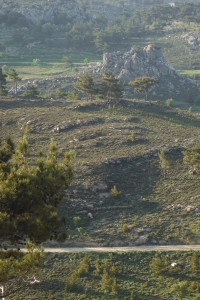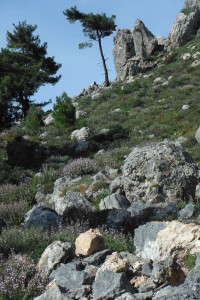I have just returned from a month-long holiday in Sicily and Crete. What I felt there, over and over, was the awe-inspiring presence of time. It was in the landscape of 400 year-old dry-stone walling; it was in a Greek theatre in a field of poppies; it was in streets with layers of civilizations visible in the walls of buildings.
We we re staying, in Crete, in a traditional village nestled half way up a mountain. Our gracious host had returned to this village from a professional life in Athens, and had rebuilt the family apartment complex, using, as much as possible, the old stones that had been lying about in ruins. Manolis taught us about the history of the place, taking us on walks through the hills, introducing us to significant family places and rituals, giving us accounts of all the edible plants through which we were walking.
re staying, in Crete, in a traditional village nestled half way up a mountain. Our gracious host had returned to this village from a professional life in Athens, and had rebuilt the family apartment complex, using, as much as possible, the old stones that had been lying about in ruins. Manolis taught us about the history of the place, taking us on walks through the hills, introducing us to significant family places and rituals, giving us accounts of all the edible plants through which we were walking.
When Manolis learned that my companion had a particular interest in the Minoans, he told us of a Minoan cave high up in the mountains above the village, and indi cated that there had been some recent archaeological interest. He showed us on a map roughly where it was. I thought, well, anyway, it will be an exhilarating walk in that limestone country of wild thyme and sage.
cated that there had been some recent archaeological interest. He showed us on a map roughly where it was. I thought, well, anyway, it will be an exhilarating walk in that limestone country of wild thyme and sage.
After an hour and half of steep rocky walking we found what could have been the cave, now a wild goat shelter. But we weren’t sure. There are lots of caves in such country, and we’d been making choices about paths all the way along. Then, about to head back, we noticed a farmer below us, tinkering with his truck. We waved, exchanged good mornings, and decided to climb down and ask for directions. I wasn’t hopeful, particularly as we spoke no Greek. But he knew why we were coming.
The farmer sat at a table, drinking a glass of his wine, and watched us scramble down. With pleasure, he showed us his vegetable garden, naming each plant in turn, and then he took us to a gate at the far side of the garden. From there, he pointed to a further gate across a small field. It all looked rather unlikely to me. But, when we got to the second gate, there it was: not a cave, but a whole recently excavated Minoan site. There were no signs, no road to it; you had to arrive through this farmer’s vegetable garden.
It felt as if people had left this 4,000 year old place only yesterday: walls, rooms clearly there, and, in three rooms, altars, intact, as if still in use. This was, then, probably a religious site, connected somehow with the cave, which we could now see above us. Shards of pottery lay everywhere in the grass. They were also now clearly visible in the nearby road that we took home. There, under our feet, pottery, thousands of years old, under the feet of generations before us, and generations to come.
The farmer had walked for years over a now excavated site. He still walks every day over buried civilizations. His vegetables grow in the soil of these civilizations. The terraces that lace these hills have been built and rebuilt over thousands of years, from the same stones, from new stones, terrace upon terrace, generation after generation. The past lives in these terraces, in the cycles of building, growing olive trees and vines and vegetables, and herding sheep and goats. And farmer and visitors alike are part of these cycles. The wonder of such experiences of the ancient yet present past is that they put our brief chronologies into perspective: we are part of a bigger life that cannot be defined by years.
Ann
You evoke the look and the feel of the place beautifully and add the essence of time so deftly.
Lovely… “the ancient yet present past”. I enjoyed vicariously experiencing the sense of wonder in this place.